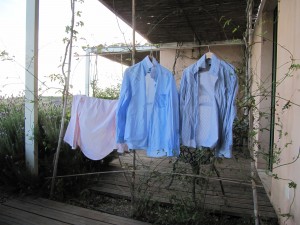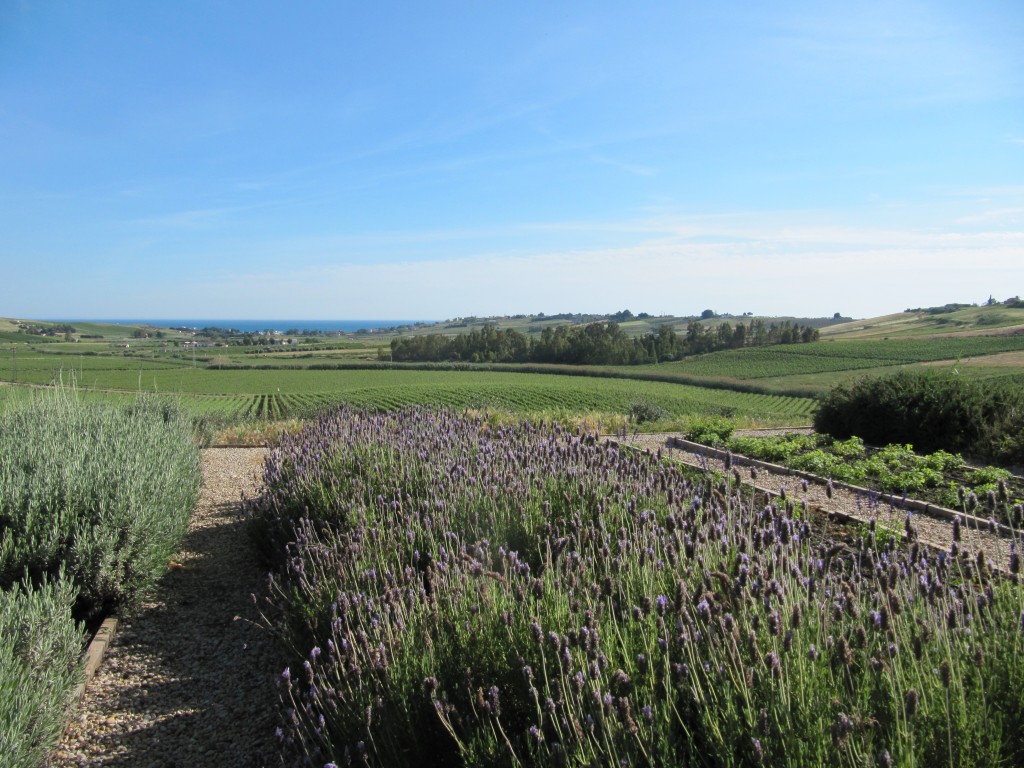 SAMBUCO DI SICILIA, Sicily. Somewhere straight ahead of me lies Africa — Tunisia, I think, though I haven’t consulted a map to confirm it. I consider this as I sit on the little porch of our room at the Planeta winery on Sicily’s southwest coast and wonder how quickly, at after five in the afternoon, I can expect one of the shirts I have just washed and hung out to become dry enough to wear to supper.
SAMBUCO DI SICILIA, Sicily. Somewhere straight ahead of me lies Africa — Tunisia, I think, though I haven’t consulted a map to confirm it. I consider this as I sit on the little porch of our room at the Planeta winery on Sicily’s southwest coast and wonder how quickly, at after five in the afternoon, I can expect one of the shirts I have just washed and hung out to become dry enough to wear to supper.
The problem is that since the room faces due south, the sun rises far to the left and sets far to the right, leaving my laundry in a kind of damp limbo. It would make sense to just lay them over the waist high lavender bushes blooming flamboyantly just a bit further out from the sitting area, but this would rightly leave me open to the disapproval of the management, not to mention some finger wagging from my my good and long-suffering wife. And so, as I wait for them to dehydrate I will take some time to compose this postcard – keeping mostly, but not exclusively to wine subjects.
This Planeta winery – I say ‘this’ because there are at least five scattered about the island – is quite amazingly beautiful. The terrain here on the coast near Menfi is gently rolling. The sea, perhaps 2 miles from the property is plainly visible between hillocks that rise in the distance.
All together, Planeta is one of the largest quality-oriented commercial wineries on the island. It has an excellent and deserved reputation for making very professional, polished wine in a place not long known for such things. Diego Planeta was a genuine pioneer in quality winemaking on Sicily, and his connections reach back with only a single degree of separation to the great Bordeaux enologist Emile Peynaud. His link with Peynaud was the celebrated Giacomo Tachis, the man who a few decades ago was almost single-handedly responsible for Sassicaia and the whole Super Tuscan category (whatever you may think about that).
The Tachis touch is evident in the amount of non-indigenous, mainly French varietals planted here (I’m referring now to all five Planeta properties) alongside native island cultivars such as nero d’avola, carricante, and frappato. Cabernet sauvignon, cab franc, syrah, merlot, chardonnay, and riesling are all rooted here and make their way into various blends and some monovarietal wines – all of which are thoroughly entirely competent and correct.
The downside is something I have frequently noted in tasting Planeta wines stateside: They seem to lack soul. The 100% single vineyard syrah I tasted at lunch this afternoon with marketing director Chiara Planeta (alas, neither a winemaker nor a vineyard manager was available for a chat) was of this stripe. The wine seemed formulaic to me, with a lot of new oak and alcohols that at 14.5 degrees threatens to disequilibriate the wine.
I can be more enthusiastic about their experiments with fiano, which here deviates from the quirky minerality of its Campanian counterpart to something more flamboyantly aromatic and tropically fruity. The difference between this and the syrah? I’m not really sure, except this wine seemed comfortable in its own skin where others did not. Also, our welcome to the property included a sparkler made from carricante grape that was really brisk and lovely. I think they have a winner there.
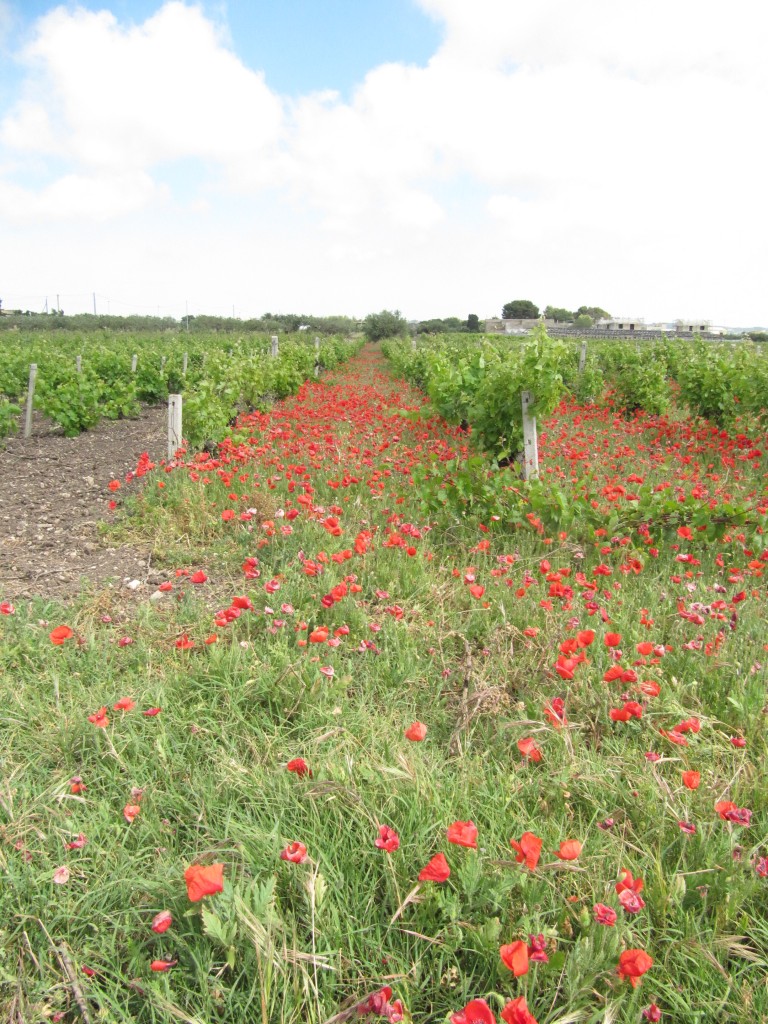 Until quite recently, the traditional vine training method in most of Sicily was albarello. In this system the vine rises only about 14-18″ out of the ground before developing two or three main branches, so that it does indeed resemble the ‘little tree’ from which the name derives. I had a good look at some vines trained in this way by the side of the road on our way to the salt pans near Agrigento . You can see the stubby little plants in the background above as well as the beautiful wild poppies and other blooming cover that sprouts exuberantly between the rows.
Until quite recently, the traditional vine training method in most of Sicily was albarello. In this system the vine rises only about 14-18″ out of the ground before developing two or three main branches, so that it does indeed resemble the ‘little tree’ from which the name derives. I had a good look at some vines trained in this way by the side of the road on our way to the salt pans near Agrigento . You can see the stubby little plants in the background above as well as the beautiful wild poppies and other blooming cover that sprouts exuberantly between the rows.
On each of these branches, very close to the trunk, two or three buds are allowed to burst, giving rise to the upright shoots that will bear fruit that year. According to Bill Nesto’s book on Sicilian wine which has been my guide here, there are a number of benefits to the albarello system. Since their heads remain low to the ground, they derive more humidity from the earth and remain out of the reach of dehydrating winds. As you can imagine, they’re squat stature makes harvest a back-breaking job, however.
Albarello-trained vines provided relatively small amounts of the highly concentrated Sicilian wine that was in demand for most of the 19th century. The largest market for these wines were properties further north (including Burgundy) where they were used to boost the often feeble output of the vineyards there. These rich, deeply-hued and robustly alcoholic supplementary wines were known as vini da taglio
At both Planeta properties we visited, they have opted for Bordeaux-style single guyot system. In this method, a single bearing cane of year-old wood is selected, shortened and trimmed to the six or eight buds from which shoots will emerge and bear fruit that year.
With vini da taglio (mostly) a thing of the past, single guyot seems to be have been adopted everywhere here. It’s one way quality-oriented winemakers have decided to put some distance between themselves and Sicily’s sketchy vini da taglio-history. There are some exceptions, however: Sylvio Foti and Frank Cornelissen among the most notable. I’ll have more on alberello-trained vines and a report on my visit with Frank in his Etna vineyards and cantina in a subsequent postcard.
All in all, Planeta seems rather to occupy an ambiguous space with its portfolio of wines saying sometimes Bordeaux and sometimes Sicily. Perhaps one day they will find a way out of what seems to me like a slightly uncomfortable position.
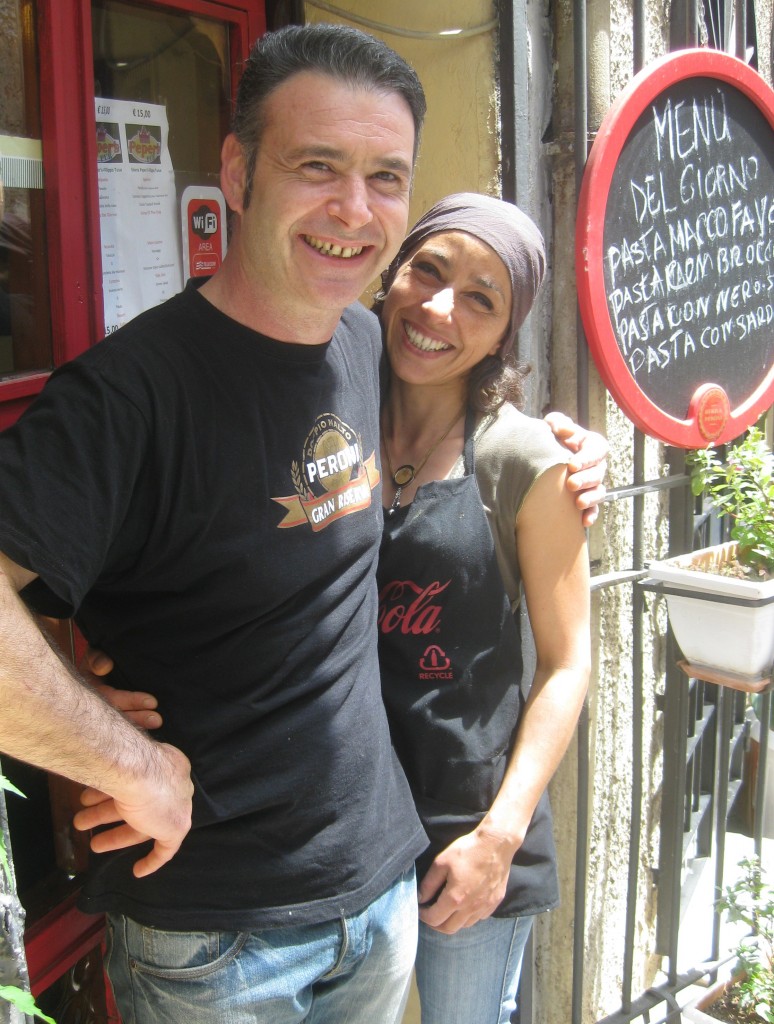 Earlier, in one of those delightful surprises one always hopes to encounter when traveling, we discovered Osteria Peper’s, a little resto in the Monreale section of Palermo where a young couple (left) served the group we are traveling with a superb lunch.
Earlier, in one of those delightful surprises one always hopes to encounter when traveling, we discovered Osteria Peper’s, a little resto in the Monreale section of Palermo where a young couple (left) served the group we are traveling with a superb lunch.
The mom of this totally charming mom and pop spent part of her early years in California and was very animated and chatty (you can see something of her brio in the photo at left). If this place were in our neighborhood we’d be worse than regulars.
Speaking of Monreale, the duomo (important church) there is my favorite of the many I have dropped into over the years in one European city or another. One reason: the humanely-scaled Romanesque proportions that predate the soaring, filigreed Gothic style by 50 years or so.
The other: the truly enchanting mosaic program that recounts the entirety of Christian redemptive history in a three-tiered band along the entire circuit of the upper walls of the church. In a tweet earlier this week I mentioned that my favorite is the depiction of the shameful behavior of the patriarch Noah, who having successfully landed the ark on Mt. Ararat took it upon himself as one of his first priorities to plant a vineyard.
He subsequently became so drunk on the proceeds of his work that he uncovered himself, giving scandal.
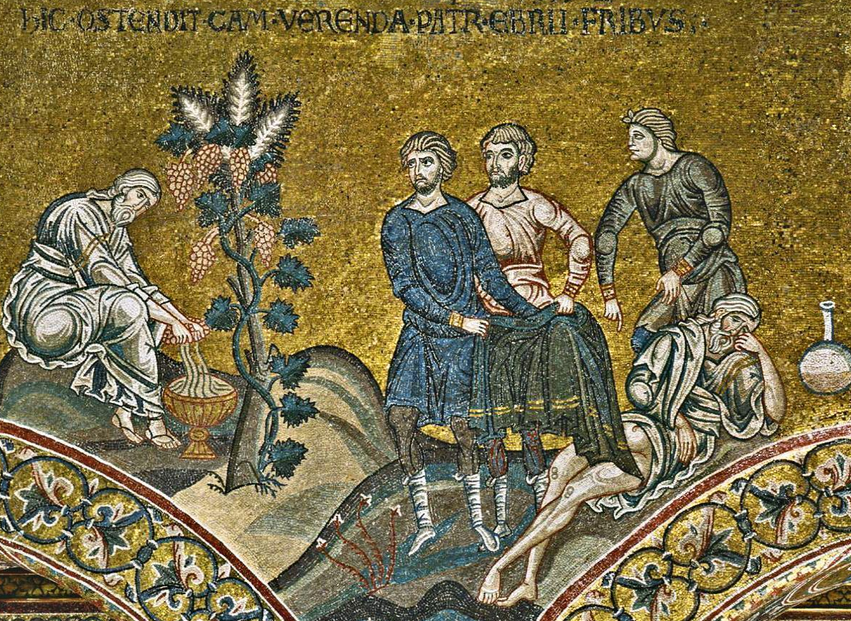 The single panel that tells this story is so cunningly and charmingly done it wins the heart. In it, Noah, whom the Flood has left bereft of a proper wine press, is seen wringing the juice from the grapes by hand just as we did a couple of weeks ago with our homemade wine at Central Bottle. See all 40 of the marvelous panels here.
The single panel that tells this story is so cunningly and charmingly done it wins the heart. In it, Noah, whom the Flood has left bereft of a proper wine press, is seen wringing the juice from the grapes by hand just as we did a couple of weeks ago with our homemade wine at Central Bottle. See all 40 of the marvelous panels here.
That’s it for now. Shirts dry!
